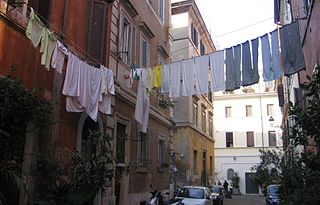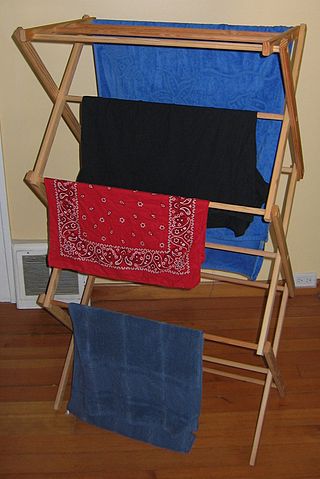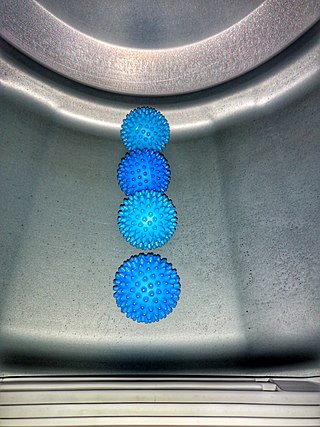
Homemaking is mainly an American and Canadian term for the management of a home, otherwise known as housework, housekeeping, housewifery, househusbandry or household management. It is the act of overseeing the organizational, day-to-day operations of a house or estate, and the managing of other domestic concerns. A person in charge of the homemaking, who is not employed outside the home, in the US and Canada, is called a homemaker, a term for a housewife or a househusband. Historically the role of homemaker was often assumed by women. The term "homemaker", however, may also refer to a social worker who manages a household during the incapacity of the housewife or househusband. Home health workers assume the role of homemakers when caring for elderly individuals. This includes preparing meals, giving baths, and any duties the person in need cannot perform for themselves.

Laundry is the washing of clothing and other textiles, and, more broadly, their drying and ironing as well. Laundry has been part of history since humans began to wear clothes, so the methods by which different cultures have dealt with this universal human need are of interest to several branches of scholarship.

A washing machine is a machine designed to launder clothing. Modern-day home appliances use electric power to automatically clean clothes. The term is mostly applied to machines that use water as opposed to dry cleaning or ultrasonic cleaners. The user adds laundry detergent, which is sold in liquid, powder, or dehydrated sheet form, to the wash water.

A home appliance, also referred to as a domestic appliance, an electric appliance or a household appliance, is a machine which assists in household functions such as cooking, cleaning and food preservation.

A clothes dryer is a powered household appliance that is used to remove moisture from a load of clothing, bedding and other textiles, usually after they are washed in the washing machine.

A laundry room or utility room is a room where clothes are washed, and sometimes also dried. In a modern home, laundry rooms are often equipped with an automatic washing machine and clothes dryer, and often a large basin, called a laundry tub, for hand-washing of delicate clothing articles such as sweaters, as well as an ironing board. Laundry rooms may also include storage cabinets, countertops for folding clothes, and, space permitting, a small sewing machine.

A clothes line, also spelled clothesline, also known as a washing line, is a device for hanging clothes on for the purpose of drying or airing out the articles. It is made of any type of rope, cord, or twine that has been stretched between two points, outdoors or indoors, above ground level. Clothing that has recently been washed is hung over the line to dry, held in place using clothes pegs or clothespins. Washing lines are attached either from a post or a wall, and are frequently located in back gardens, or on balconies. Longer washing lines often have props holding up the mid-section so the weight of the clothing does not pull the clothesline down to the ground.
A fabric softener or fabric conditioner is a conditioner that is applied to laundry after it has been washed in a washing machine. A similar, more dilute preparation meant to be applied to dry fabric is known as a wrinkle releaser.

A cupboard is a piece of furniture for enclosing dishware or grocery items that are stored in a home. The term gradually evolved from its original meaning: an open-shelved side table for displaying dishware, more specifically plates, cups and saucers.

The term "clothes horse" is used to refer to a portable frame upon which wet laundry is hung to dry by evaporation. The frame is usually made of wood, metal or plastic. It is a cheap low-tech piece of laundry equipment, as opposed to a clothes dryer, which requires electricity to operate, or a Hills Hoist, which requires ample space, wind and fine weather. It also served as an alternative to an airing cupboard. In cold, damp seasons and in the absence of central heating, a clothes horse placed by a fireside or a kitchen range provides a place to warm clothing before putting it on. The practice of airing, once ubiquitous in Great Britain, for example, in the constant battle against damp and mold, has become far less common with the advent of central heating and affordable clothes dryers.
A utility room is a room where equipment not used in day-to-day activities is kept. "Utility" refers to an item which is designed for usefulness or practical use, so in turn most of the items kept in this room have functional attributes. A utility room is generally the area where laundry is done, and is the descendant of the scullery.

A combo washer dryer is a combination in a single cabinet of a washing machine and a clothes dryer. It should not be confused with a "stackable" combination of a separate washing machine and a separate clothes dryer.
A wardrobe, also called armoire or almirah, is a standing closet used for storing clothes. The earliest wardrobe was a chest, and it was not until some degree of luxury was attained in regal palaces and the castles of powerful nobles that separate accommodation was provided for the apparel of the great. The name of wardrobe was then given to a room in which the wall-space was filled with closets and lockers, the drawer being a comparatively modern invention. From these cupboards and lockers the modern wardrobe, with its hanging spaces, sliding shelves and drawers, evolved slowly.

A self-service laundry, coin laundry, or coin wash, is a facility where clothes are washed and dried without much personalized professional help. They are known in the United Kingdom as launderettes or laundrettes, and in the United States, Canada, Australia and New Zealand as laundromats. In Texas and other parts of the south central United States, the term washateria is still used by some older speakers. The first laundromat opened on April 18, 1934 in Fort Worth, Texas.
Staber Industries, Inc. is a manufacturer of residential laundry home appliances, with headquarters in Groveport, Ohio. The products they currently manufacture include a washing machine, a clothes dryer, and a clothes drying cabinet.

A dryer ball is a spherical laundry device for tumbling clothes dryers used as an alternative to fabric softener, reducing static electricity or softening clothing, or to accelerate the drying process.

An overhead clothes airer, also known variously as a ceiling clothes airer, laundry airer, pulley airer, laundry rack, or laundry pulley, is a ceiling-mounted mechanism to dry clothes. It is also known as, in the North of England, a creel and in Scotland, a pulley.

Airing is the practice of hanging or laying out articles and exposing them to air, and sometimes heat and light. This practice is commonly used to dry many types of fabric. One of the most common methods of drying using airing is the clothesline. It consists of a thin wire from which clothing pieces and bedsheets are hung, using pegs or simply laying the article over the line.

A drying room is a room intended for drying objects. It can act as a replacement or complement for drying cabinets, tumble-dryers, and outdoor drying. Compared to outdoor drying, a drying room means one usually does not have to consider the weather forecast in case of rain.
















